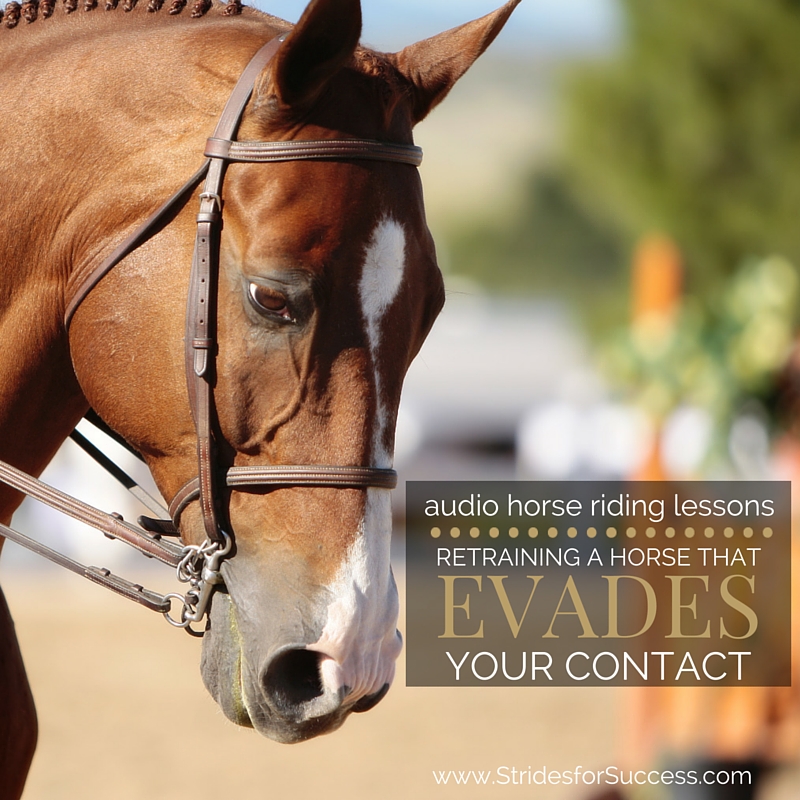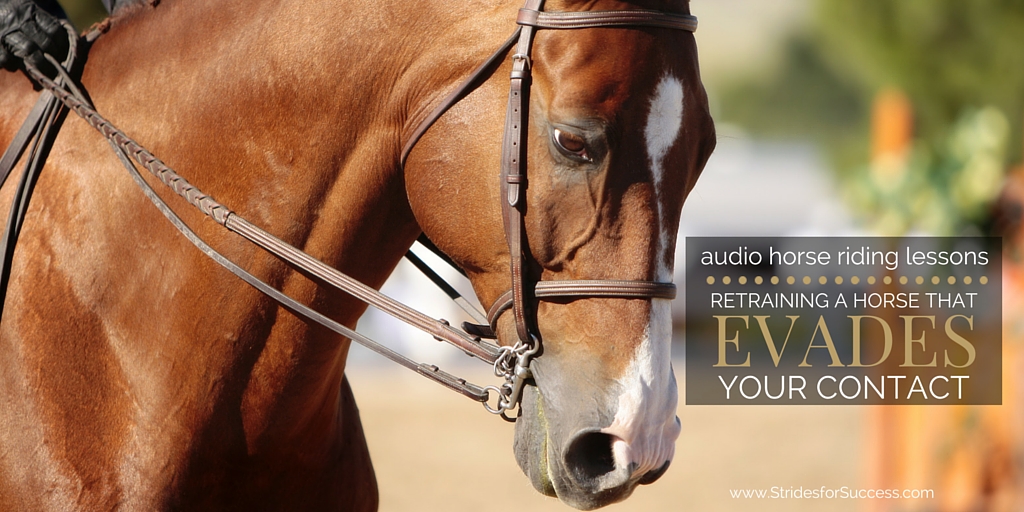Are there days where your horse’s camel impression is worryingly accurate? He lounges along, his back all strung out resembling a cable that’s sole purpose is to work against you. His neck stretched out in what must be an extremely uncomfortable way, his nose pointing skyward… And it seems that all your efforts to establish a correct contact are falling on deaf ears?!
Or perhaps your horse is the other end of the spectrum? As soon as you pick up a contact he curls his head so his lips are close to touching his chest… Leaving you with loopy reins that have no contact at all with said horse’s mouth?!
The unfortunate fact is that horses evade contact in many different ways and for many different reasons which all have the potential to ruin a good performance or ride. However before we go any further, let’s get clear on what is correct, ‘true contact when riding a horse…
What is True Contact?
Contact is your connection with your horse through your rein aid. You must offer a stable, consistent contact through your hand and rein, which in turn, your horse will then accept with his mouth. However, the contact that we can ‘see’ in the above description is merely the end result of a lot of other communications and aids.
Things that are ongoing and happening between horse and rider. Their culmination is what produces a consistent, soft, and accepting contact.
In order to create correct contact, the horse must be moving forward from behind. So the rider must first work on activating the hindquarters, then allowing that energy to connect through to the front, before they can then harness and direct it using their contact.
Responsibility and Responsiveness
In order to achieve correct contact you need to be responsible and your horse must be responsive.
This means that you are conscientious in how you ask for and respond to your horse’s contact that will cause no discomfort or pain to your horse. He must be perceptive and reactive to your aids when he receives them.
Very often riders forget or just don’t know about the first, vitally important, responsibility on their part in order to achieve a correct contact. Because of this, they become focused on ‘head carriage’. Or if their horse is ‘on the bit’.
Instead, I want you to think of contact as being the result of a carefully set up and orchestrated use of your different aids when in the saddle. And this culminates in your horse accepting your conscientious, soft, and elastic contact.
How Does a Horse Evade the Contact?
So, how does a horse evade the bit or contact? Horses generally do this in a few different ways. They either become ‘above the bit’. This is where their noses are ‘skyward’ and the whole back, from tail to ears, is hollow.
Or they can also become ‘behind the bit’. This is when they begin to curl their head and neck back towards their body, nose to chest, which leaves the rider very little options when it comes to contact at all.
Lastly, there are some horses that when you have ‘closed’ all open doors, will still try to evade by wriggling around, never truly connecting with the rider through the reins at all. It feels like someone has replaced your horse with an eel!

Why Does a Horse Evade the Contact?
All of the above descriptions lead to a less than pleasant picture to look at. And all also look extremely uncomfortable for the horse! So what is it exactly that brings them to act like this?
-
-
- The rider is asking incorrectly – This can be due to ignorance or incorrect training on the riders part. Very often riders will only focus on their horse’s head and where it is, rather than what is happening underneath them that is leading their horse to travel like that.
- Unsteady contact from the rider – Many riders continue to do this, even though they understand and know about the importance of a steady and ‘safe’ contact for their horse.
-
Some riders continue to use the reins as a safety harness rather than work on developing an independent seat.
-
-
- The horse is unbalanced – Young and underdeveloped horses will find it difficult to accept a contact for any great length of time. This needs to be worked on and developed slowly, over time, using correct aids and techniques, in a way the horse can understand and trust.
- Over or incorrect use of a gadget or training aid – This is particularly evident with the usage of draw reins, where horses begin to evade the contact by coming behind the vertical or bit.
- The horse’s conformation makes him more inclined to travel like this initially
- Physical discomfort – Such as pain in the back due to tack or another disease or injury. Also problems with teeth and correct fitting of the bit. All physical discomfort should be ruled out before continuing on with and retraining your horse.
-
Contact as a Development Step
So often we think of contact as being just holding the reins, however the contact that you create is so much more than that. This is both in terms of communication between horse and rider and also as a vital piece to moving on up the training scale with your horse later.
It is your job as the rider to create or provide a contact that is consistent, kind, soft, following yet effective.
Once you have done this, your horse can then accept this contact and trust you that you won’t catch him in the mouth or drop him by releasing and letting go of the contact.
Your level of contact will depend on how much energy you are asking your horse to create with his hind quarters. Contact is merely gathering up and then giving that energy some focused direction of where to go
Therefore it is impossible to have contact if you horse is not using his hind quarters to push himself forward and having forward energy. It is the lack of this forward momentum that causes a horse to begin to lean or become heavy on your hand and essentially evade the bit.
Reschooling a More Correct Contact
So assuming that you have an independent seat and your hands are thoughtful and balanced, once a horse has begun to evade how can you then begin to re-school or retrain him to a better way of going? Nne where he is happy to accept your contact?
-
-
- Forwardness & Responsiveness
- Rhythm
- Suppleness
- Straightness
-
Begin working on assessing how responsive your horse is to your aids. If you ask for more, does he respond and begin creating a little more energy into his movement? Is this response immediate or does he think about it for a few steps? If his response time is a little ‘wanting’ I suggest carrying a schooling whip and backing up your leg aids with it each time he shows begins to procrastinate or ignore your aids.
Once he is responsive then make sure he is indeed moving forward, pushing from behind. It is impossible to direct what is not there, so make sure your horse is using his hindquarters with each stride.
Then work on creating a rhythm in the gait you have chosen. I suggest working on a 20m circle, and using half halts and transitions on the circle to further engage the hindquarters as your horse is working.
Straightness to Enhance Contact
Straightness is important. Firstly to correctly channel the energy where you want it to go. But also so you can quickly lock any doors that your horse will try to open once you have blocked his initial ‘evade of choice’!
Many horses will look for another way of evading when you shut down the initial window of opportunity!
Finally, don’t be afraid of creating contact with your horse while riding. Many riders are worried about hurting their horse’s mouth, or pulling on the reins and never truly get to experience and feel how wonderful it is to communicate with their horse in a consistent, safe, following contact.
Happy Riding
Lorna
Additional Resources for Equestrians:-
-
-
-
- Why Forward is Essential for Contact
- Improving Your Riding Coordination & Aids While Lunging
- Join Connection today and transform your riding journey
- Lunging for Riding – 4-week step by step program to transform your lunging experience
- Online community for equestrians working on their mindset & fitness
- Online Community for equestrians focusing on re-schooling horses (and ex-racehorses)
- The Daily Strides Podcast on iTunes
- Daily Strides Podcast on Google Play
- The Daily Strides Podcast on Stitcher Radio
-
-


1 Comment